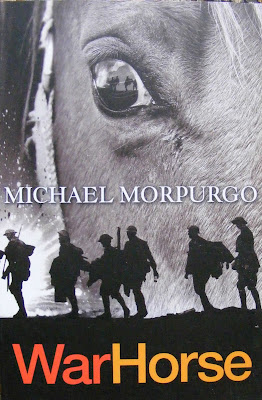PBOTD: 13th March, Anna Sewell - Black Beauty
If you should ever happen to mention to someone that you like horse books, you can pretty much guarantee that they will think you mean Black Beauty (1877), and will quite possibly be puzzled by the fact there were more horse stories after this. Black Beauty Black Beauty didn't really start the genre that became the pony book: it was part of a rich tradition of animal stories which had started in the 1700s, mostly aimed fairly and squarely at improving the moral sense of their readers. From Mary Pilkington’s Marvellous Adventures; or, the Adventures of a Cat (1802) to Mary Martha Sherwood’s The Little Woodman, and his Dog Cæsar, (1818), animal story authors aimed at the improvement of their infant readers, and at better treatment for their animal subjects.
 |
| Jarrolds, undated, internal illustration Cecil Aldin |
Anna Sewell was not concerned just with the treatment
of horses. Humans suffer too. It is not just Beauty who descends through society. In one of the most tragic episodes in the book, the evils of drink lead
Rueben Smith, otherwise a sensible and efficient groom, to wound Beauty and
kill himself in a drunken accident, and his wife “with her six little children,
were obliged once more to leave the pleasant home by the tall oak trees, and go
into that great gloomy Union House’” or workhouse, a fate dreaded by the poor
because of the harsh conditions within. Reuben’s fate, though, lay mostly in
his own hands. The fate of the horse did not.
 |
| Dent, 1915, internal illustration, Lucy Kemp Welch |
Black Beauty has a fine and fair start in life. He's broken in with kindness and understanding. His good start continues when he is sold as a carriage horse to
the enlightened Squire Gordon, who treats his animals and staff well, and who
never uses the bearing rein, that strap attached to the harness of a driving
horse to keep its head up. Although a loosely adjusted bearing rein can be
useful in preventing a horse evading control, Victorian fashion decreed such
tight bearing reins that horses’ heads were forced out of their natural
carriage, and kept there for hours at a time. While Black Beauty is at Birtwick
Park, life goes well, but the horses are sold up when the Squire and his wife
move abroad for her health. Beauty’s next home is Earlshall Park, where he
experiences the horrors of the bearing rein and the drunken Rueben Smith.
 |
| Blackie, 1958, illustrated Sheila Rose |
After the accident, in which Beauty’s knees
are so badly scarred he is no longer considered fit for a grand stable, he is
sold, and so his long, slow deterioration starts, as he is sold from one owner
to another. He experiences the full
range of human stupidity and ill treatment, eventually collapsing through
overwork. Unlike many horses, he was
fortunate enough to be rescued, and eventually serves out a contented
retirement, back with one of his early grooms.
 |
| Puffin, pb, 1964, illustrated Charlotte Hough |
Black Beauty’s enormous popularity influenced the equine story for decades after it was published in 1877. Horse after horse, pony after pony, all underwent the same progression, with an ultimate rescue by the enlightened by the end of the book.
Anna Sewell died in 1878, just five months after the publication of her book. Although the book was already successful, its tremendous, and enduring, popularity has been unlike any other horse story.
I think it's safe to say Black Beauty has been published in more editions than any other horse book. I have therefore just included my favourites here. It is possible to get hold of editions of the Cecil Aldin and Lucy Kemp Welch versions which don't have as many pictures as the originals, but which are still well worth getting. Black Beauty has also appeared in slightly less likely guises: here he is as a Tennessee Walking Horse. If ever there was a horse in need of the sort of welfare reforms Anna Sewell advocated, it is the Tennessee Walking Horse. Nearly 150 years after she wrote, this breed is still subject to appalling cruelty in an attempt to produce the showy gate "the Big Lick."
 |
| American edition |
~ 0 ~
Anna Sewell has a whole section to herself on my site, where you can see many more editions than the ones I've managed to include here.

Comments